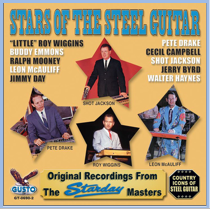This is Bob Hempker with today’s newsletter. I want to address the left hand technique. The bar, not unlike the volume pedal, is also an instrument unto itself. Much of a players style can be defined by their left hand technique.
Let’s face it, the basic purpose of the bar is to note the strings with the left hand as opposed to a guitar, bass, mandolin, or type of instrument that you would note with the fingers of your left hand. We can also look at it as a movable capo.
We can also use it to bend a string just slightly if it’s out of tune or if we want a slur type of effect. If we hear a lower string somewhat out of tune, we can put more pressure on the back of the bar.
Sometimes, I like to use bar slants or reverses in lieu of using pedals or knee levers. Or use them with pedals and knee levers for wider intervals. It’s like if a guitar player had longer fingers to reach an extra fret with.
Some of us older players that started out with a six-string lap guitar remember having to play slants and reverses. We had no other choice. I’m sure some of you older players remember the “black rajah” bar. They also made a red one. I remember learning to play slants and reverses on a lap guitar with one of these bars.
Sometimes when playing a song, during a certain passage I’ll use a knee lever or pedal for a particular voicing that I want to use, then maybe the next time through I’ll use a bar slant or reverse. Sometimes the bar slant or reverse has a more soulful sound to it because it’s not perfectly in tune like a knee lever or pedal.
It’s also easier to slur the string raise or lower, faster or slower than even a pedal. Bobbe’s Slants and Reverses DVD provides a wonderful education in this technique. I think that being fluent in slants and reverses adds depth to a players style thus making him more enjoyable to listen to.
One of the things I notice from beginning players especially that come into the store is the erratic left hand. The proper way to hold the bar is with your thumb to the right of the bar, your index finger on top of the bar and your other three fingers at an angle behind the bar.
When you move your bar from one position to the other, slide it. Never pick it up. When you pick your bar up to move it, your playing sounds choppy and unrefined. Only pick your bar up when you’re finished playing and you’re putting your bar and picks away before you get up from your guitar and walk away.
I don’t want to address pull-offs, mordents and those type of things. That is a whole completely different type of bar technique. I’m only talking about basic bar technique in this newsletter.
I like to look at bar vibrato in a similar fashion as a vocalist would use vibrato with their voice. When used sparingly and in the proper places, it can enhance your playing. But if it’s used all the time and is exaggerated, it can become annoying to the listener. We can’t overlook little things like this. They are what separates real musicians from just hackers.
Work on your left hand technique and never stop working on it. Use your ear and listen to what you’re playing. You can record what you’re playing and hear what the audience hears you play on the playback.
In my last newsletter, I addressed the volume pedal. The volume pedal and the bar are two of the most important things about our instrument. The bar more than anything else helps make our instrument its own unique instrument. It is the personality of the steel guitar.
You may want to try different sizes of bars. The 7/8ths inch bar has become pretty much the standard, but the 1 inch bar and the 31/32nd bars are useful for certain things. Sometimes the bigger, heavier bars will give you more sustain.
I like the bigger diameter bar when I’m playing ballads up high on the neck. It seems like I can hear the strings go into pitch better using the bigger diameter bars. But by the same token, when I’m playing down near the low end of the guitar, I have to watch and listen or I’ll be playing sharp.
I personally don’t care for bars that are hollowed out inside because you lose sustain and a big part of steel guitar tone is sustain. I have not tried the zirconia bars. I don’t know anything about them but I’ve heard people say that they work well.
Experiment with different bars and you might find you want to use different bars for playing different things. Or you may settle on one particular bar that you like.
If you use a Bobro or Dobro simulator of some sort, it’s good to use a light plastic bar because you don’t want the sustain and they’ll ever so slightly deaden the strings just enough to help give it a Dobro sound.
We have a wide enough selection of bars to give you all the choices you need. I highly recommend the Cobra Coil bars we sell, not just because I work here, but because they are really good bars.
www.steelguitar.net
sales@steelguitar.net
www.youtube.com/bobbeseymour
Listen To Steel Guitar Music Streaming 24 Hours A Day!
Steel Guitar Nashville
123 Mid Town Court
Hendersonville, TN. 37075
(615) 822-5555
Open 9AM – 4PM Monday – Friday
Closed Saturday and Sunday


